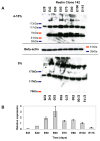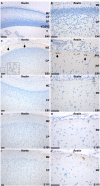Reelin expression during embryonic development of the pig brain
- PMID: 20550682
- PMCID: PMC2895594
- DOI: 10.1186/1471-2202-11-75
Reelin expression during embryonic development of the pig brain
Abstract
Background: Reelin is an extracellular glycoprotein of crucial importance in the developmental organisation of neurons in the mammalian cerebral cortex and other laminated brain regions. The pig possesses a gyrencephalic brain that bears resemblance to the human brain. In order to establish an animal model for neuronal migration disorders in the pig, we have studied the expression pattern and structure of Reelin during pig brain development.
Results: We determined the sequence of pig Reelin mRNA and protein and identified a high degree of homology to human Reelin. A peak in Reelin mRNA and protein expression is present during the period of major neurogenesis and neuronal migration. This resembles observations for human brain development. Immunohistochemical analysis showed the highest expression of Reelin in the Cajal-Reztius cells of the marginal zone, in resemblance with observations for the developing brain in humans and other mammalian species.
Conclusions: We conclude that the pig might serve as an alternative animal model to study Reelin functions and that manipulation of the pig Reelin could allow the establishment of an animal model for human neuronal migration disorders.
Figures



Similar articles
-
Impaired Reelin-Dab1 Signaling Contributes to Neuronal Migration Deficits of Tuberous Sclerosis Complex.Cell Rep. 2015 Aug 11;12(6):965-78. doi: 10.1016/j.celrep.2015.07.013. Epub 2015 Jul 30. Cell Rep. 2015. PMID: 26235615 Free PMC article.
-
LIM-homeobox gene Lhx5 is required for normal development of Cajal-Retzius cells.J Neurosci. 2010 Aug 4;30(31):10551-62. doi: 10.1523/JNEUROSCI.5563-09.2010. J Neurosci. 2010. PMID: 20685998 Free PMC article.
-
Proteolytic cleavage of transmembrane cell adhesion molecule L1 by extracellular matrix molecule Reelin is important for mouse brain development.Sci Rep. 2017 Nov 10;7(1):15268. doi: 10.1038/s41598-017-15311-x. Sci Rep. 2017. PMID: 29127326 Free PMC article.
-
Role for Reelin in stabilizing cortical architecture.Trends Neurosci. 2010 Sep;33(9):407-14. doi: 10.1016/j.tins.2010.06.001. Epub 2010 Jul 1. Trends Neurosci. 2010. PMID: 20598379 Review.
-
[Functions of Reelin in cortical neuron migration].Seikagaku. 2016 Feb;88(1):105-13. Seikagaku. 2016. PMID: 27025013 Review. Japanese. No abstract available.
Cited by
-
Controversies in RELN/reelin expression in otosclerosis.Eur Arch Otorhinolaryngol. 2012 Feb;269(2):431-40. doi: 10.1007/s00405-011-1653-4. Epub 2011 Jun 1. Eur Arch Otorhinolaryngol. 2012. PMID: 21630058
-
A novel, clinically relevant use of a piglet model to study the effects of anesthetics on the developing brain.Clin Transl Med. 2016 Mar;5(1):2. doi: 10.1186/s40169-015-0079-9. Epub 2016 Jan 12. Clin Transl Med. 2016. PMID: 26757938 Free PMC article.
-
Characterization of hippocampal Cajal-Retzius cells during development in a mouse model of Alzheimer's disease (Tg2576).Neural Regen Res. 2014 Feb 15;9(4):394-401. doi: 10.4103/1673-5374.128243. Neural Regen Res. 2014. PMID: 25206826 Free PMC article.
-
Use of a Piglet Model for the Study of Anesthetic-induced Developmental Neurotoxicity (AIDN): A Translational Neuroscience Approach.J Vis Exp. 2017 Jun 11;(124):55193. doi: 10.3791/55193. J Vis Exp. 2017. PMID: 28654034 Free PMC article.
-
Cerebral organoids and their potential for studies of brain diseases in domestic animals.Vet Res. 2021 May 3;52(1):65. doi: 10.1186/s13567-021-00931-z. Vet Res. 2021. PMID: 33941270 Free PMC article. Review.
References
Publication types
MeSH terms
Substances
LinkOut - more resources
Full Text Sources

